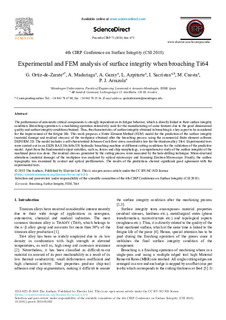Título
Experimental and FEM analysis of surface integrity when broaching Ti64Autor-a
Autor-a (de otra institución)
Versión
Version publicada
Derechos
© 2018 Elsevier B.V.Acceso
Acceso abiertoVersión del editor
https://doi.org/10.1016/j.procir.2018.05.033Publicado en
Procedia CIRP Vol. 71. Pp. 466–471. 6 June 2018Primera página
466Última página
471Editor
ElsevierPalabras clave
BroachingSurface Integrity
FEM
Ti64
Resumen
The performance of aeronautic critical components is strongly dependent on its fatigue behavior, which is directly linked to their surface integrity condition. Broaching operation is a machining opera ... [+]
The performance of aeronautic critical components is strongly dependent on its fatigue behavior, which is directly linked to their surface integrity condition. Broaching operation is a machining operation extensively used for the manufacturing of some features due to the good dimensional quality and surface integrity condition obtained. Thus, the characteristics of surface integrity obtained in broaching is a key aspect to be considered for the improvement of the fatigue life. This work proposes a Finite Element Method (FEM) model for the prediction of the surface integrity (material damage and residual stresses) of the workpiece obtained after the broaching process using the commercial finite element software DEFORM 2D. The model includes a self-characterized Johnson-Cook flow stress constitutive law for the titanium alloy Ti64. Experimental tests were carried out in an EKIN RAS 10x160x320 hydraulic broaching machine at different cutting conditions for the validation of the predictive model. Apart from the fundamental output variables, such as, forces and chip morphology, a comprehensive study of the surface integrity of the machined piece was done. The residual stresses generated by the cutting process were measured by the hole-drilling technique. Microstructural alterations (material damage) of the workpiece was analyzed by optical microscopy and Scanning Electron Microscope. Finally, the surface topography was examined by contact and optical profilometers. The results of the predictions showed significant good agreement with the experimental tests. [-]
Sponsorship
The authors hereby thank the Basque and Spanish Government projects respectively AEROBROCH (UE2016‐07), GENTALVE (KK-2016/00059), MICROMAQUINTE (PI_2014_1_116), EMULATE (DP12015-67667-C3-3R) and in the grant for Education and Training of Research Staff (PRE_2017_1_0394). The authors thank the Laboratory Technicians Denis Soriano and Erika Dominguez for their assistance in the realization of experimental tests and surface integrity analysis.ID Proyecto
GE/Programa Estatal de Investigación, Desarrollo e Innovación Orientada a los Retos de la Sociedad, Convocatoria 2015, Modalidad 1: Proyectos de I+D+I/DPI2015-67667-C3-3-R/ES/Modelización y análisis experimental del proceso de mecanizado en la escala micro/EMULATEColecciones
- Artículos - Ingeniería [735]
El ítem tiene asociados los siguientes ficheros de licencia:






















